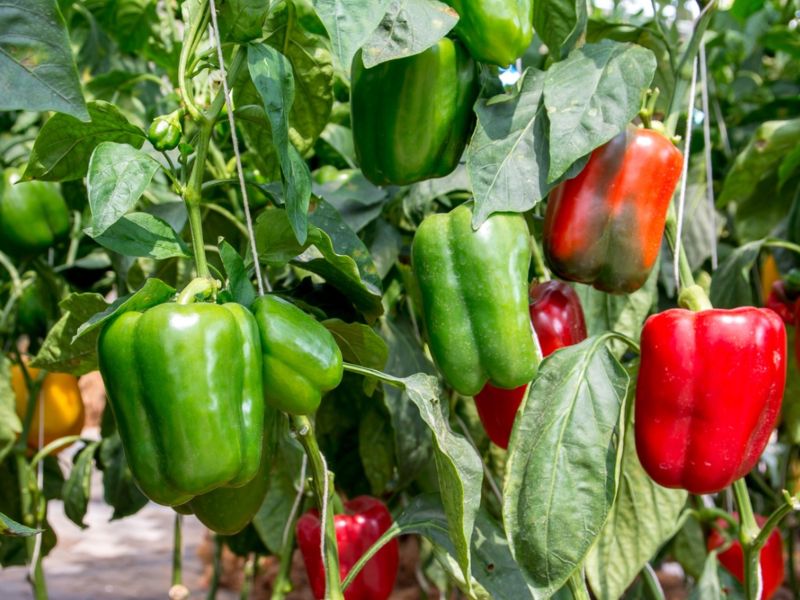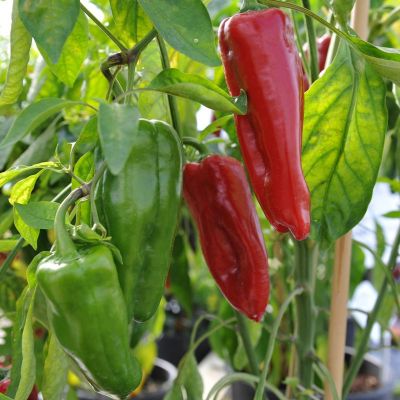Bell peppers are among the most consumed vegetable. We basically use this crop daily in our food. Therefore, is one of the most recommended veggies to grow. The best part about growing Bell Peppers is that you don’t need a garden space to grow them as they grow perfectly in containers.
In fact, these trees are sensitive to frost, so growing them in containers and moving them around when the weather is not suitable anymore is highly recommended.
Please find below a full guide on how to grow Bell Peppers in A pot.

1. Propagating
Bell peppers can be grown from seeds or seedlings. Seeds are more recommended as according to experienced gardeners, propagating from seeds always give the best result. However, if you’re growing from seedlings, we recommend Bonnie Plants Lunchbox Sweet Snacking Pepper and Jalapeño hot pepper, as in contrast to larger varieties of pepper seeds that can tower over 3 feet tall. Luckily, many hot pepper plants are naturally small in stature.
As per the seeds, you will need to buy them online or better locally from your nursery store. Make sure you get good quality seeds. Quality seeds will resist the frost, bad weather, and germinate faster. The germination usually takes between 1 to 3 weeks depending on the weather conditions and seed quality.
2. Choosing A Container
Peppers bell require a big sized pot to thrive and grow productive. These plants can grow to enormous sizes, especially in the right conditions, hence, the ideal pot will be at least 10-12 inches deep and wide and has sufficient drainage holes. In such as pot, you can grow only 1 plant if you’re growing a big variety and you can grow up to 3 plants if you have chosen a small variety.
We recommend a container with holes in the bottom or drill your own to ensure adequate drainage. The material that you pick for your container matters as well. For example, you don’t want a black pot if you live in a tropical or hot region.Use a plastic or metal pot in favour of fast-drying terra cotta, especially because peppers require consistently moist soil.
3. Soil
Bells peppers are sensitive, and they need a good quality soil to grow and produce. Thus, please buy the best quality potting mix you can afford. The soil should be well drained, loose and fertile. You should also add some well-rotted manure or compost in the combination of peat moss/coco peat and vermiculite or perlite (alternatively, sand) to ensure the soil is rich in organic matter.
4. The Spot for Bell Peppers In Containers
The minimum soil temperature for Bell peppers seed to germinate is 68 F (20 C) and the minimum soil temperature for the plants to grow is 60 F (15 C). When looking for a spot for your plants, please remember that the ideal growing temperature is between 70-90 F (21-32C).
These plants are sun loving therefore they need a spot where the can get at least 6 hours of direct sunlight. We recommend that you put them in the sunniest spot around your house or garden for best result.
5. Watering and Feeding
The watering of Bell peppers depends on the season and the climate. For example, when in summer, these moist loving plants will require frequent watering. In hot areas, the watering should be as frequent as once per day.
This does not mean to keep watering your plants until you drown the root. These plants do not tolerate waterlogged soil. It would be best to check the first layer of the soil surface to see if it is dry or not. Dry means watering required whereas moist means no watering is needed.
These heavy feeders require fertilization once every 3 weeks. You can apply natural, organic plant food designed for fruits and vegetables such as tomatoes fertilizers. You can also mulch the plants by adding organic matter such as leaves, pine barks, straws, paper. This will help keep the soil moist.
6. Caring for Bell Peppers in A Pot
In order to promote bush growth, always pinch off growing tips. Also watch out for early flowers and remove them so you orient plant’s energy into growing and becoming healthy. Some gardeners recommend the removal of early fruits too.

Another important tip is to support your plant with a stick. The stem of pepper is weak, and the plant may fell when it reaches a certain height. You will also need to look after your plants from pests and diseases such as aphids as they are the number one enemy of pepper plants. Spiders mites can attack you plant in dry and hot weathers.
7. Harvesting
Bell peppers mature usually in 3 to 4 months. Their colour will become green and they will have a hot scent. If you don’t harvest them right away, their colour may change to yellow, orange or red.

We will be happy to answer all the questions and queries you leave in the comments below.

